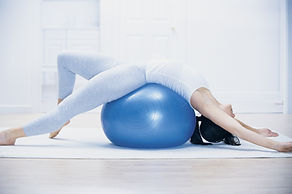
Pilates and Spinal Stenosis
Spinal Stenosis
Spinal stenosis was once called creeping paralysis, because people believed that the condition was untreatable.
Spinal stenosis occurs when the spinal canal narrows, compressing the spinal cord and nerves and causing paralyzing back pain.
Pilates may be used as part of a doctor-approved physical therapy routine to help reduce spinal stenosis pain by lengthening and mobilizing the back muscles and strengthening the spine-stabilizing core muscles.
Stenosis usually involves the narrowing of:
The spinal canal in the centre of the column of bones (spinal column) through which your spinal cord and nerve roots pass.
The spinal foramen openings between your spinal vertebrae through which nerves leave the spine and go to other parts of the body.
Spinal stenosis most often results from a gradual, degenerative ageing process of your spine.
As you age, the ligaments of your spine may thicken and calcify, and start to compromise the adjacent tunnels.
Your bones and joints also tend to enlarge due to increased bone stress and cause bone spurs, which encroach in the spine’s space.
Your spinal discs, between the vertebrae, become dehydrated with age and lose their height. This disc narrowing can deteriorate quicker with injury eg disc bulges or degenerative disc disease.
Osteoarthritis of your spine is the most common form of arthritis and is more likely to occur in middle-aged and older people. It is a chronic, degenerative process. It is the result of everyday wear and tear of the spine joints, and is often accompanied by overgrowth of bone, formation of bone spurs, which can cause spinal stenosis.
Spinal stenosis is most common in men and women over 50 years of age and is related to degenerative changes in the spine. However, it may occur in younger people who are born with a narrowing of the spinal canal or who suffer an injury to the spine.
What are the Symptoms of Spinal Stenosis?
Most commonly, spinal stenosis sufferers experience numbness, muscle weakness, diminished reflexes cramping or general pain in the arms or legs.
The exact symptoms depend upon which part of your spine is stenotic.
The most common stenosis regions of your spine are your lumbar spine (low back) and your cervical spine (neck), but any spinal region can suffer stenosis.
In lumbar spinal stenosis, the spinal nerve roots in the lower back are compressed and this can produce symptoms of pain, tingling, weakness or numbness that radiates from the low back and into the buttocks and legs, especially with activity.
Cervical stenosis may cause similar symptoms affecting your arms and potentially your legs too!
If the narrowed space within the spine is pushing on a nerve root, you may feel pain radiating down the nerve eg sciatica.
However, unlike patients who have sciatica due to slipped disc, this sciatica is relieved by sitting down in stenotic patients.
Classically, in stenosis patients, sitting or bending forward to flex the spine should relieve your symptoms. The flexed position “opens up” the spinal column and therefore enlarges the spaces between the vertebrae.
Because keeping the lower back ‘flexed' (bent forward) relieves their symptoms, patients will often walk with a slight stoop forward or look downwards.
Pilates is very helpful for people with spinal stenosis when they know the right exercises to do for this condition.
The article above is from
http://www.physioworks.com.au/injuries-conditions-1/spinal-stenosis
For further information, please do not hesitate in contact us.
info@connecthealthandfitness.com



